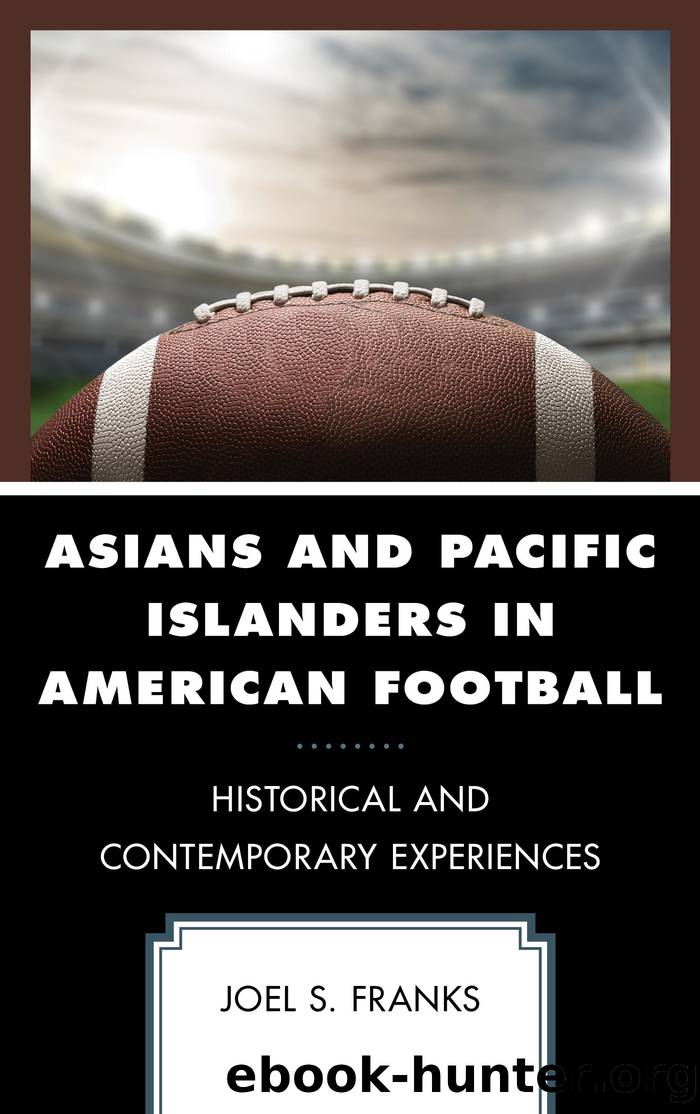Asians and Pacific Islanders in American Football by Franks Joel S.;

Author:Franks, Joel S.;
Language: eng
Format: epub
Tags: undefined
Publisher: Lexington Books
Published: 2012-08-15T00:00:00+00:00
PostWar Years
After World War II, Asian Americans showed up on several high school football rosters on the West Coast and elsewhere. In Southern California, within weeks of V-J Day, Wayne Tsukahira played center for Belmont High. The next year, he made all league. In the fall of 1940, the Los Angeles Timesâ John De La Vega maintained that San Fernando High depended on âLarry Woo, 140-pound Chinese quarterback to engineer T-attack.â In November 1945, Woo keyed San Fernandoâs whitewash of Canoga Park, 26â0. A few weeks later, he scored the only touchdown in a San Fernando loss. To the south, Garden Grove High School was captained by Tak Matsunaga in 1949. A 165-pound guard, Matsunaga also made second team all-league.[32]
In the early to mid-1950s, several Japanese Americans illuminated Southern Californiaâs prep gridirons denied them almost a decade earlier by internment. Ralph âthe Rabbitâ Kubota glittered as a 135-pound halfback for Compton High School in the late 1940s and early 1950s. In 1950, Kubota ran for touchdowns of seventy-one and seventy-three yards against Excelsior. He also staged a brilliant performance in Comptonâs CIF (California Interscholastic Federation) championship game against Fullerton. Indeed, he was named to the first string all-CIF team two years running, leading all Southern California backs in yards gained as he accumulated over 1,100. The Pacific Citizen pointed out that Kubota was the smallest back to make the all-CIF squad. In late summer of 1951, Kubota shined in a high school all-star game when he âscooted 40 yards around endâ to set up a touchdown.[33]
Kubota then moved up to Compton Junior College, a perennial powerhouse in Southern California junior college grid circles. Some of the greatest players of postwar American football such as running backs Joe Perry and Hugh McElhenny, as well as the aforementioned Charlie Ane, had performed for the Tartars. Early in October 1951, Kubota scored two touchdowns of fourteen and twenty-five yards as Compton walked over Joliet Junior College, 59â0. A couple of weeks later, Kubota ran a touchdown in from fourteen yards as Compton beat Ventua, 21â7. The same month, Kubota scampered for two touchdowns of sixteen and seventeen yards when Compton edged San Angelo College, 14â13.[34]
While Kubota performed well for Compton, Benny Aoki was doing even better as a running back for Long Beach Junior College. Aoki was the son of Japanese immigrant parents living in Torrance at the time of the 1940 census. His father was described in the census manuscript schedules as a farmer. Prior to attending Long Beach JC, Aoki had sparked Long Beach High Schoolâs backfield. The high schoolâs yearbook described him as a âspeed merchant,â who, in 1948, tallied twice with runs of over fifty yards against San Diegoâs Hoover High. Aoki also scored twice against Orange Countyâs Excelsior High. One of the touchdowns was a âsensational runâ of thirty-two yards. Aoki, moreover, was given the General George S. Patton Award as the varsityâs Most Inspirational Player.[35]
Out of high school, Aoki sustained his football heroics. Early in October 1951,
Download
This site does not store any files on its server. We only index and link to content provided by other sites. Please contact the content providers to delete copyright contents if any and email us, we'll remove relevant links or contents immediately.
| Americas | African Americans |
| Civil War | Colonial Period |
| Immigrants | Revolution & Founding |
| State & Local |
In Cold Blood by Truman Capote(3134)
Steve Jobs by Walter Isaacson(2759)
The Innovators: How a Group of Hackers, Geniuses, and Geeks Created the Digital Revolution by Walter Isaacson(2481)
All the President's Men by Carl Bernstein & Bob Woodward(2260)
Lonely Planet New York City by Lonely Planet(2099)
The Room Where It Happened by John Bolton;(2031)
And the Band Played On by Randy Shilts(2008)
The Murder of Marilyn Monroe by Jay Margolis(1976)
The Poisoner's Handbook by Deborah Blum(1976)
The Innovators by Walter Isaacson(1967)
Lincoln by David Herbert Donald(1866)
A Colony in a Nation by Chris Hayes(1796)
Under the Banner of Heaven: A Story of Violent Faith by Jon Krakauer(1681)
Amelia Earhart by Doris L. Rich(1582)
The Unsettlers by Mark Sundeen(1581)
Birdmen by Lawrence Goldstone(1530)
Zeitoun by Dave Eggers(1514)
Dirt by Bill Buford(1513)
Decision Points by George W. Bush(1462)
